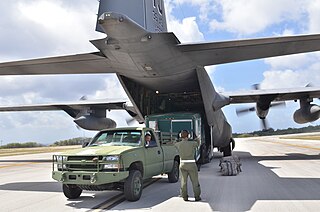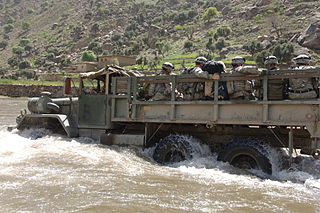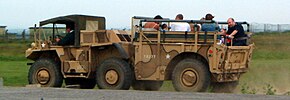
The High Mobility Multipurpose Wheeled Vehicle is a family of light, four-wheel drive, military trucks and utility vehicles produced by AM General. It has largely supplanted the roles previously performed by the original jeep, and others such as the Vietnam War-era M151 Jeep, the M561 "Gama Goat", their M718A1 and M792 ambulance versions, the Commercial Utility Cargo Vehicle, and other light trucks. Primarily used by the United States military, it is also used by numerous other countries and organizations and even in civilian adaptations.

An amphibious vehicle is a vehicle that works both on land and on or under water. Amphibious vehicles include amphibious bicycles, ATVs, cars, buses, trucks, railway vehicles, combat vehicles, and hovercraft.

In the 1950s, LeTourneau Inc. developed several overland trains, essentially oversized semi-trailer trucks that could travel over almost any terrain. Their intention was to be able to handle logistics needs without being dependent on local road or rail systems, allowing them to operate in back-country areas. The US Army had three experimental units built, the largest reaching almost 600 feet (183 m) long, which holds the record for the longest off-road vehicle. Road trains are in use in certain roles today, but the US Army examples and a few derivatives appear to be the only off-road examples built.

The Medium Tactical Vehicle Replacement (MTVR) is a series of vehicles used by the U.S. Marines. The first MTVRs were delivered in late 1999. The MTVR is the equivalent of the U.S. Army's Family of Medium Tactical Vehicles (FMTV); the Marines do not use the FMTV and the Army does not use the MTVR.

Six-wheel drive is an all-wheel drive drivetrain configuration of three axles with at least two wheels on each axle capable of being driven simultaneously by the vehicle's engine. Unlike four-wheel drive drivetrains, the configuration is largely confined to heavy-duty off-road and military vehicles, such as all-terrain vehicles, armored vehicles, and prime movers.

Mowag is a Swiss company founded in 1950, which develops, designs and produces armoured fighting vehicles for military applications in both land-only and amphibious configurations. These vehicles have gross vehicle weights ranging from 9 tonnes to 30 tonnes. In 2003, the company was acquired by General Dynamics, and is now known as GDELS-Mowag, part of General Dynamics European Land Systems (GDELS).

A tractor unit, also known as a truck unit, lorry unit, power unit, prime mover, ten-wheeler, semi-tractor, semi-truck, semi-lorry, tractor cab, truck cab, lorry cab, big rig tractor, big rig truck or big rig lorry or simply a tractor, truck, lorry, semi, big rig or rig, is a characteristically heavy-duty towing engine that provides motive power for hauling a towed or trailered load. These fall into two categories: heavy- and medium-duty military and commercial rear-wheel-drive semi-tractors used for hauling semi-trailers, and very heavy-duty typically off-road-capable, often 6×6, military and commercial tractor units, including ballast tractors.

The Commercial Utility Cargo Vehicle, later the Light Service Support Vehicle (LSSV), is a vehicle program instituted to provide the United States military with light utility vehicles based on a civilian truck chassis.

The M520 "Truck, Cargo, 8-ton, 4x4", nicknamed Goer, truck series was formerly the US Army’s standard heavy tactical truck before its replacement by the Oshkosh HEMTT. As trucks go, the Caterpillar-made Goer stands out due to being articulated, much wider than other trucks, and lacking suspension on the wheels.

An articulated hauler, articulated dump truck (ADT), or sometimes a dump hauler, is a very large heavy-duty type of dump truck used to transport loads over rough terrain, and occasionally on public roads. The vehicle usually has all-wheel drive and consists of two basic units: the front section, generally called the tractor, and the rear section that contains the dump body, called the hauler or trailer section. Steering is made by pivoting the front in relation to the back by hydraulic rams. This way, all wheels follow the same path, making it an excellent off-road vehicle.

The M39 series 5-ton 6×6 truck (G744) was a family of heavy tactical trucks built for the United States Armed Forces. The basic cargo version was designed to transport a 5-ton (4,500 kg), 14 ft (4.3 m) long load over all terrain in all weather. In on-road service the load weight was doubled.

The URO VAMTAC is a Spanish four-wheel drive military vehicle manufactured by UROVESA. Externally it is similar in appearance and design to the Humvee of the United States Military due to similar requirements. More than 2,000 of the vehicles have been delivered to the Spanish Armed Forces. Several other countries operate the VAMTAC as well, and it has seen in service most recently in Afghanistan and Syria. The vehicle comes in three models, named I3, S3 and ST5, and has several configurations.

Military light utility vehicle, or simply light utility vehicle (LUV), is a term used for the lightest weight class military vehicle category. A Jeep-like four-wheel drive vehicle for military use by definition lighter than other military trucks and vehicles, inherently compact and usually with light or no armour, with short body overhangs for nimble all-terrain mobility, and frequently around 4-passenger capacity.

The Amphibious truck "Su-Ki" was a World War II Japanese military vehicle manufactured by the Toyota Motor Co., Ltd, similar in concept to the GMC DUKW. It entered service in 1943 and was used by Japanese forces in the Pacific during World War II.

The AEC Militant was a post-war development by AEC of the AEC Matador artillery tractor used during World War II. Externally the most noticeable development was the cab, which was considerably enlarged. Unlike the Matador only six-wheel versions were produced. Four-wheel versions are extant, but they are probably conversions and one is a Matador with a Mk1 Militant cab. Other changes included the fitting of a larger, 11.3-litre 6-cylinder, diesel engine and the use of a steel frame for the cab, rather than the ash (fraxinus) wood frame of the Matador. The Militant Mark 1 was produced in 6x4 and 6x6 form.

The Mack M123 (G792) was a 10-ton 6x6 semi-tractor introduced in 1955. The Mack M125 was a heavy cargo truck version of the M123. The M123 was used to tow tank transporter trailers while the M125 towed field artillery pieces.

The M809 Series 5-ton 6x6 truck (G908) was a family of heavy tactical trucks built for the United States Armed Forces. The basic cargo version was designed to transport a 5-ton (4,500 kg), 14 ft (4.3 m) long load over all terrain in all weather. In on-road service the load weight was doubled. Built by AM General, they evolved into the M939 Series.

The SAMIL 20 is a 2-ton cargo vehicle produced in South Africa in the mid-1980s and was used as the primary light cargo carrier of the South African National Defence Force. The vehicle design is based on the German Mercedes Unimog chassis and Mark I of this vehicle was based on the Magirus Deutz 130M7FAL 4x4 truck. In Mark II, the engine was replaced with an upgraded South African built water cooled diesel engine. The vehicle is still in use with the SANDF.



















